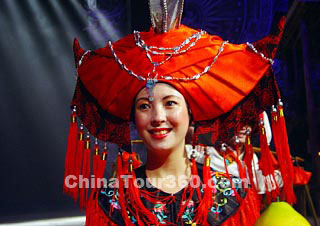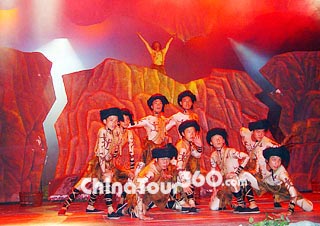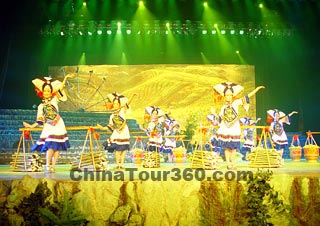The Zhuang, with a population of 16,178,811 in the year 2000, is the largest ethnic group in China. Most of the people live in compact communities in Guangxi Zhuang Autonomous Region, with the rest scattered throughout Yunnan, Guangdong, Guizhou and Hunan provinces.
 |
| Zhuang People in Traditional Costume |
The ancestors of the Zhuang were a branch of the ancient Baiyue people, who lived in south China.
The Zhuang ethnic group has its own language, which belongs to the Zhuang-Dai branch of Zhuang-Dong Austronesian, part of the Sino-Tibetan family of languages. Although the language has its own characters, they are underdeveloped and dated. Chinese was widely used among the Zhuang people until 1955, when a writing system based on the Latin alphabet was created by the Zhuang, with the help of central government.
The Zhuang region enjoys a mild climate and abundant rainfall, which supports tropical and subtropical crops such as rice, yam, corn, sugar cane, bananas, longan, litchis, pineapples, shaddock and mangos. Rice and corn make up the Zhuangs' staple diet, with pork, beef, mutton, and poultry the popular meat consumed.
Zhuang people mostly worship nature and their ancestors, with only a small ethnic group Christian.
Although today there is no obvious difference in the contemporary clothing of Zhuang and Han, the traditional Zhuang costume, worn on special occasions, is unique in its style. Women wear collarless, embroidered and trimmed jackets buttoned to the left together with baggy trousers, embroidered belts and shoes, and pleated skirts. They often bind their heads with black cloth. Men wear long collarless clothes or short shirts, long trousers with girdles on, bind their heads with cloth, and wear cloth shoes.
They are adept at singing and dancing. Common musical instruments include the suona (Chinese cornet), bronze drum, cymbal, gong, sheng (Chinese wind pipe), xiao (vertical bamboo flute), di (Chinese flute) and huqin (a stringed instrument made of horse bones). Zhuang dances are characterized by distinct themes, forceful and nimble steps, jocular and humorous gestures and realistic emotions. The Timbal, a kind of ceremonial utensil representing power and fortune and also a sacred musical instrument, is especially favored by all Zhuangs.
|
|
Zhuang brocade, which is the most famous of the Zhuang crafts, is colorful and durable. It is used in the manufacture of carpets, aprons, satchels, headbands and girdles.
The traditional festivals of Zhuang include: the Devil Festival, the Ox Soul Festival, and the Singing Festival (on the Third of the Third lunar Month). The Devil Festival, which falls on July 14 on the lunar calendar (usually in August on the Gregorian calendar), is an important occasion, second only to the Spring Festival. On that day, families prepare chicken, duck and five-colored glutinous rice to be offered as sacrifices to ancestors and spirits.
The Ox Soul Festival is on the 8th of the fourth lunar month. It is said that this day is the birthday of the King of Oxen, so oxen are relieved of their yokes and the animals are washed and put out to pasture with abundant water and grass. The people sing folksongs and feed the oxen with steamed black rice. The Ox soul Festival demonstrates the people's care for their farm cattle and their anticipation of a bumper harvest.









